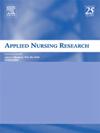“Improving postnatal maternity care following severe perineal trauma by evaluating end-user's experiences of a pilot trial exploring laxative management; A qualitative study”
IF 2.2
4区 医学
Q1 NURSING
引用次数: 0
Abstract
Background
Trauma to the anal sphincter following vaginal birth increases the risk of anal incontinence. Laxative management in the postnatal period is recommended to improve defecation and reduce the risk of wound breakdown. Research underpinning management guidelines is lacking and omits end-users (clinicians and birthing women) involvement in evaluating pilot studies. Incorporating end-users' enhances the relevance of the research to those being investigated, improves the design, and translation of findings into clinical practice. No studies have evaluated end-users' experiences in research which investigates laxative management following anal sphincter injury.
Aim
This study identifies the barriers and facilitators in a pilot study research design and suggests improvements to inform larger scale research to improve clinical practice.
Methods
A phenomenological qualitative study using semi-structured interviews was adopted. Purposeful sampling of health professionals (n = 85) involved in the direct care of women following OASIs and women (n = 64) sustaining OASIs during the recent pilot trial. Data analysis employing thematic analysis.
Findings
The consensus from interviews (n = 23) highlighted the research was feasible with suggested improvements to enhance future recruitment, information for linguistically diverse women and review of quality-of-life tools. The evaluation process enhanced future research engagement.
Conclusions
The reliability and validity of future research can be improved adopting a qualitative framework and end-users' to evaluate pilot studies. Findings from this pilot study identified issues including recruitment, CALD participant information and accuracy of QoL data collection tools that needed to be addressed enhancing future findings that are relevant to the needs of the study population and enhance translation into practice.
“通过评估最终用户对探索泻药管理试点试验的体验,改善严重会阴创伤后的产后产妇护理;一项定性研究”
阴道分娩后肛门括约肌损伤增加肛门失禁的风险。建议在产后使用泻药,以改善排便,减少伤口破裂的风险。缺乏支持管理指南的研究,并且忽略了最终用户(临床医生和分娩妇女)参与评价试点研究。将最终用户纳入研究,增强了研究与被调查对象的相关性,改进了设计,并将研究结果转化为临床实践。在调查肛门括约肌损伤后泻药管理的研究中,没有研究评估最终用户的经验。目的本研究确定了试点研究设计中的障碍和促进因素,并提出了改进建议,为更大规模的研究提供信息,以改善临床实践。方法采用半结构化访谈法进行现象学定性研究。在最近的试点试验中,有目的的抽样调查了参与直接护理接受绿洲治疗的妇女的卫生专业人员(n = 85)和维持绿洲治疗的妇女(n = 64)。数据分析采用主题分析。调查结果从访谈(n = 23)中得出的共识强调了该研究的可行性,并提出了改进建议,以加强未来的招聘,为语言多样化的女性提供信息,并审查生活质量工具。评估过程加强了未来的研究参与。结论采用定性框架和最终用户评价试点研究,可提高未来研究的信度和效度。这项试点研究的结果确定了需要解决的问题,包括招募、CALD参与者信息和生活质量数据收集工具的准确性,这些问题可以增强与研究人群需求相关的未来研究结果,并增强对实践的转化。
本文章由计算机程序翻译,如有差异,请以英文原文为准。
求助全文
约1分钟内获得全文
求助全文
来源期刊

Applied Nursing Research
医学-护理
CiteScore
4.50
自引率
0.00%
发文量
65
审稿时长
70 days
期刊介绍:
Applied Nursing Research presents original, peer-reviewed research findings clearly and directly for clinical applications in all nursing specialties. Regular features include "Ask the Experts," research briefs, clinical methods, book reviews, news and announcements, and an editorial section. Applied Nursing Research covers such areas as pain management, patient education, discharge planning, nursing diagnosis, job stress in nursing, nursing influence on length of hospital stay, and nurse/physician collaboration.
 求助内容:
求助内容: 应助结果提醒方式:
应助结果提醒方式:


